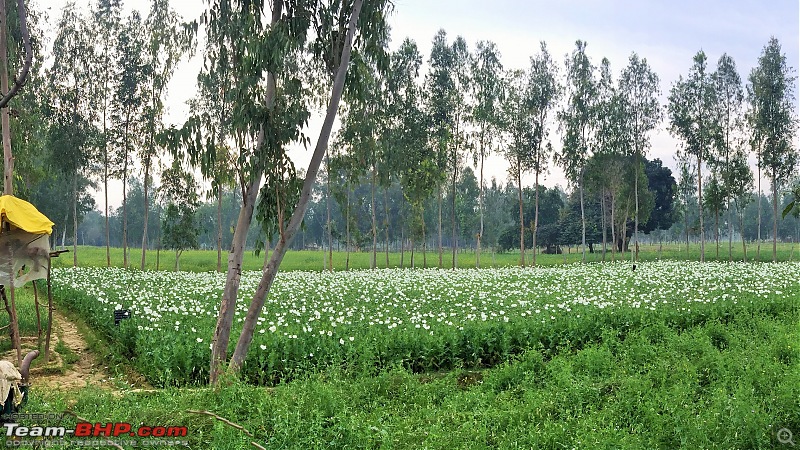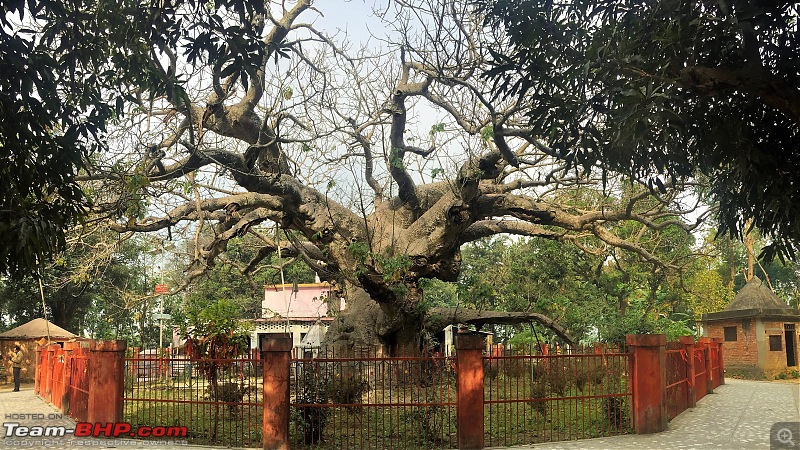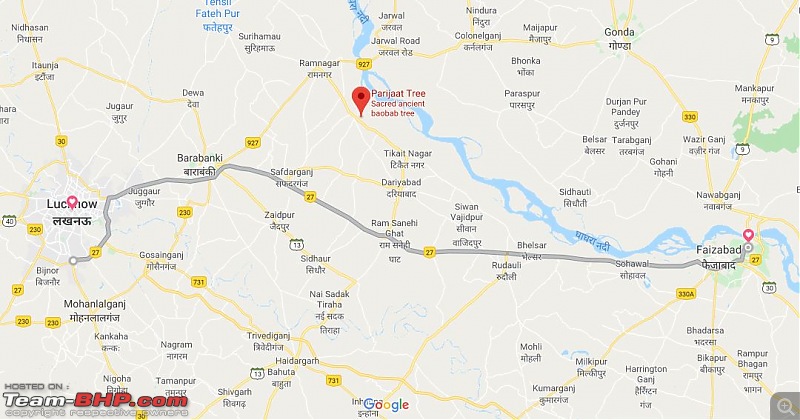There are travels which you plan well in advance and some which are planned in the nick of time. We were on one such trip to Ayodhya, back in February 2019, a meticulously planned one. We had to attend a friend's wedding and could not miss the opportunity to visit the controversial holy grounds. It was winter time and covering the whole 650 kms to and fro on a Sunday would have meant a touch and go at Ayodhya. We decided to break the journey in Lucknow and had booked an OYO on Shaheed Path (which is Lucknow's ring road).
The plan was to -
- Leave on Saturday after work, break at Lucknow for the night. (190 km)
- Begin on Sunday to to reach Ayodhya by 11:00 AM. (150 km)
- Roam around till 4:00 PM.
- Attend the wedding and leave for Lucknow by 10:00 PM. (150 km)
- Start early morning on Monday to punch in at office time. (190 km)
On the early morning drive to Ayodhya from Lucknow one cannot miss the sign indicating the way to Parijat Tree. Once spotted, it is hard to undermine the tree’s significance. Road signs usually do not direct you to trees. With some spare time at our disposal we could not miss the opportunity to have a look.
- It is said that flowers from the Parijat tree were brought by Narad from heaven and were presented to Krishna. Krishna gave these flowers to Rukmini, much to the anguish of Satyabhama who thought she was Krishna’s favourite (wife). Out of jealousy, she demanded Krishna to bring the tree itself to be planted near her house.
- Some believe that Arjun brought the tree from heaven for his mother Kunti, who offered its flowers to Lord Shiva.
- Another fable describes the tree to have grown from Kunti’s ashes.
 Poppy plantations along the rural roads on the detour.
Poppy plantations along the rural roads on the detour.  Poppy flowers.
Poppy flowers.
The 20 km detour to Kintoor from the Lucknow-Faizabad highway, takes you over rural roads lined with Poppy plantations to reach the fabled tree. It is the only tree in the district of Barabanki which is protected by the order of the district magistrate. Being more than 1000 years old, the adjoining temple, a bearded old Pujari sitting next to it and the prayer flags lining the way to the entrance of the compound give it an idyllic setting for the fables it is known for.
The sacred
Baobab tree (
Adansonia digitate) has been known for ages for its medicinal value, as a food producer, and the superstitions it has been engulfed in. Tribes in Africa greatly value the tree which grows in Sub-Saharan climate; even today. How then, is it growing here in India? To begin, it hasn’t been documented anywhere else in India, which intensifies the mystery. For now, it is safe to believe that it might have been brought here by an ancient traveler upon his return from Africa.
 The Tree as it stands today.
The Tree as it stands today. (February 2019)
Brought in as a seed or a sapling, intentionally or otherwise, the tree is a sight to behold. The trunk has a girth of more than 10 meters at its widest. Though not as imposing as the Banyans in the Botanical Garden of Kolkata, the tree looks majestic in its own unique way. Some nodes and features on the trunk resemble human faces when viewed at certain angles. Its branches spread out wide but are still close to the ground and within reach. It is said to flower rarely with beautiful and fragrant white flowers. The leaves in the lower part of the canopy grow in groups of five resembling a human hand (hence the word
digitate) and the ones higher up in groups of seven. The fact that the tree does not fruit and its cuttings have not given rise to another sapling in all these years lends the tree a sage-like character. The logical explanation of its existence keeps slipping out of one’s mind while admiring the tree.
As visitors, we could only try to capture its solitude in pictures. Our foraging for some fallen dried leaves and twigs to keep as souvenirs got noticed by the old Pujari. He called my wife and handed her some fallen dried flowers from the tree which we could not have reached for on our own. Before leaving we made our wishes under the Kalpvriksha (wish tree) that it is also considered by many, due to its resemblance to the Parijat tree of the fables.
Coming back to the impromptu nature of the visit. My wife and I reflect how it became the highlight of our trip to Ayodhya. The original destination turned out to be a big let-down, sparing the peaceful boat ride on the Sarayu.
 Google Maps Plus Code
Google Maps Plus Code:
2F3J+9P Baraulia, Uttar Pradesh (copy and paste full code which is underlined)
For people planning to visit; here are
a few tips.
- Factor in 1.5 hrs for the visit. (off and back on NH 27 - Lucknow-Faizabad highway)
- Exclude Tuesdays if you want to visit in peace.
- Fill your stomachs and empty your bladders before taking the detour.
- The Pujaris looks stern but are just waiting to make a few bucks in exchange for some leaves / twigs / flowers.
- Ask for directions in the last 1.5 km rather than relying on navigation apps.
- There is a large field outside the compound for parking.
- Beware of monkeys. Don't carry food / packets / flashy items.
Fun fact I stumbled upon today: The river close to the tree in the map is the
same Ghaghara river which we crossed in march this year during our trip to Katarniyagjat Wildlife Sanctuary. The same river flows by Ayodhya and is called The Sarayu.
 (18)
Thanks
(18)
Thanks
 (11)
Thanks
(11)
Thanks

 (1)
Thanks
(1)
Thanks
 (6)
Thanks
(6)
Thanks
 (3)
Thanks
(3)
Thanks
 (1)
Thanks
(1)
Thanks
 (1)
Thanks
(1)
Thanks
 (1)
Thanks
(1)
Thanks
 (1)
Thanks
(1)
Thanks
 (1)
Thanks
(1)
Thanks









